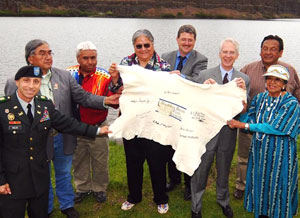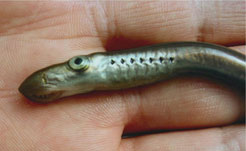- Reclamation
- Columbia-Pacific Northwest Region
- Programs & Activities
- Federal Columbia River Power System
- Columbia Basin Fish Accords
Federal Columbia River Power System
Columbia Basin Fish Accords
FCRPS Home | Hydrosystem | Hatcheries | Tributary Habitat Program | Tributary Habitat RME | Fish Accords
 In 2008 BPA, USACE, and Reclamation (also known as the FCRPS Action Agencies) entered into six agreements with six Tribes and two states (collectively known as the Fish Accord Partners). The six Tribes and two states are: the Confederated Tribes of the Warm Springs Reservation of Oregon, the Confederated Tribes of the Umatilla Indian Reservation, the Confederated Tribes and Bands of the Yakama Nation, and the Columbia River Inter-Tribal Fish Commission (collectively known as the Lower River Tribes); the Colville Tribes; the Shoshone-Bannock Tribes; the Kalispel Tribe; the State of Idaho; and the State of Montana. The Memorandums of Agreement address direct and indirect effects of construction, inundation, operation and maintenance of the FCRPS and Reclamation’s Upper Snake projects on fish resources of the Columbia River Basin.
In 2008 BPA, USACE, and Reclamation (also known as the FCRPS Action Agencies) entered into six agreements with six Tribes and two states (collectively known as the Fish Accord Partners). The six Tribes and two states are: the Confederated Tribes of the Warm Springs Reservation of Oregon, the Confederated Tribes of the Umatilla Indian Reservation, the Confederated Tribes and Bands of the Yakama Nation, and the Columbia River Inter-Tribal Fish Commission (collectively known as the Lower River Tribes); the Colville Tribes; the Shoshone-Bannock Tribes; the Kalispel Tribe; the State of Idaho; and the State of Montana. The Memorandums of Agreement address direct and indirect effects of construction, inundation, operation and maintenance of the FCRPS and Reclamation’s Upper Snake projects on fish resources of the Columbia River Basin.
The Action Agencies and the Fish Accord Partners intend the agreements to:
- resolve issues between the Fish Accord Partners regarding the Action Agencies’ compliance with the Endangered Species Act at FCRPS and Upper Snake projects
- resolve issues between the Fish Accord Partners and the Action Agencies regarding compliance with the Pacific Northwest Electric Power Planning and Conservation Act and the Clean Water Act
- address the Fish Accord Partners’ and the Action Agencies’ mutual concerns for certainty and stability in the funding and implementation of projects for the benefit of fish affected by the FCRPS and Upper Snake projects, affirming and adding to the actions proposed in the FCRPS and Upper Snake Biological Opinions
- foster a cooperative and partnership-like relationship in implementation of the mutual commitments in the Agreements
In 2018, the Action Agencies and Fish Accord Partners extended the 2008 Accords through September 2022.
Reclamation's Fish Accord activities and partnerships are described below.
More information about the Columbia Basin Fish Accords >>
Lamprey
 Pacific lamprey (Lampetra tridentata) are a resource of great significance and importance to Tribes in the Pacific Northwest, serving both as a traditional and ceremonial food source, and as medicine for tribal members. Pacific lamprey also provide numerous ecologically important benefits to aquatic ecosystems, such as a food source for juvenile salmon, birds, and mammals, and historically were a source of marine-derived nutrients that helped sustain aquatic and terrestrial ecosystems.
Pacific lamprey (Lampetra tridentata) are a resource of great significance and importance to Tribes in the Pacific Northwest, serving both as a traditional and ceremonial food source, and as medicine for tribal members. Pacific lamprey also provide numerous ecologically important benefits to aquatic ecosystems, such as a food source for juvenile salmon, birds, and mammals, and historically were a source of marine-derived nutrients that helped sustain aquatic and terrestrial ecosystems.
In addition to the implementation and funding of fisheries and habitat-related actions to improve fish survival under the Fish Accords, Reclamation undertakes additional actions specifically for the benefit of Pacific lamprey. In the Fish Accords, Reclamation agreed to identify Reclamation projects in the Columbia River Basin that may affect lamprey, investigate potential effects, and, where appropriate, make recommendations for either further study or for actions that may be taken to reduce effects on lamprey with the priority focus on the Umatilla and Yakima basin projects.
Reclamation’s “Assessment of Bureau of Reclamation Projects in the Columbia River Basin: Effects on Pacific Lamprey" documents the activities undertaken to satisfy the Fish Accords commitment to identify Reclamation projects that may affect Pacific lamprey, investigate potential effects, and make recommendations for further study or actions.
Reclamation has either been involved in or supported a number of studies and activities to further define and/or address lamprey issues as recommended by the Assessment. Background information, activity updates, and future plans are summarized in Reclamation’s Pacific Lamprey 2011 Annual Report and 2012 Plan.
Reclamation’s work at Prosser Dam in the Yakima River provided adult lamprey passage with a wetted wall structure that mimics a waterfall. For juvenile lamprey, Reclamation is testing how to reduce their entrainment in canals. Traditional fish screens are not effective at keeping young lamprey out of canals, due to the juveniles’ very small size. Reclamation is testing a number of techniques such as using pumps or hydraulic structures to change how water, and therefore young lamprey, flows past the fish screens.
John Day
The Confederated Tribes of Warm Springs have provided successful leadership in developing and implementing stream habitat improvement projects that benefit salmon and steelhead in the John Day Basin. Under the FCRPS BiOp and associated Fish Accords, Reclamation has furthered its long term partnership with the Tribes by providing technical assistance in support of the stream habitat improvement projects.
Salmon Creek, Okanogan Basin Water Acquisition
Salmon Creek in Washington was historically-renowned for an abundance of salmon and steelhead. Diversion of water for irrigation in Salmon Creek and other activities through the Columbia River Basin since the early 1900s reduced the capacity of Salmon Creek steelhead to reproduce in former numbers and led to the extirpation of Salmon Creek Chinook Salmon.
In a continuing effort to reverse the effects of these past activities on federally-listed and depressed anadromous fish, the Confederated Tribes of the Colville Reservation (Colville Tribes), the Okanogan Irrigation District (OID), and Reclamation have worked together to provide water for fish passage from the mouth of Salmon Creek to upstream of the OID’s diversion dam.
The Colville Tribes’ Salmon Creek Project is directed at improving migration conditions in this productive tributary of the Okanogan River. Adding stream flows when fish return to spawn results in increased number of steelhead accessing the high quality habitat that exists in Salmon Creek thereby increasing natural production of endangered Upper Columbia River steelhead.
This project is related to the Chief Joseph Hatchery Project, as Salmon Creek will provide the primary habitat in the Okanogan Basin for reintroduction of Upper Columbia spring Chinook.
Under the 2008 Fish Accord, Reclamation provides funding to increase stream flow in Salmon Creek. This water will aid Upper Columbia steelhead migration and reintroduction of Upper Columbia spring Chinook in Salmon Creek.
| Related Information | |
| 09/2013 | Pacific Lamprey 2012 Annual Report and 2013 Plan PDF 10.3 mb |
| 12/2011 | Columbia River Intertribal Fish Commission – Tribal Pacific Lamprey Restoration Plan HTML |
Contact
Public Affairs Office
pninfo@usbr.gov
208-378-6231
Bureau of Reclamation
Columbia-Pacific Northwest Region
Columbia/Snake Salmon Recovery Office
1150 N Curtis Road, Suite 100
Boise, Idaho 83706

